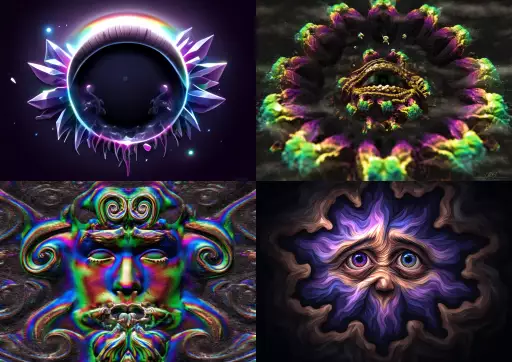Explore the Best AI Image Gallery

Beyond the Brush: How Edge Computing Is Unleashing Creative Potential
The intersection of technology and creativity has always been a fertile ground for innovation. From the printing press to the digital revolution, each technological leap has reshaped how we create and consume art. Today, edge computing stands at the precipice of ushering in a new era of creative possibilities.
Edge computing, characterized by processing data closer to its source, is moving beyond traditional applications like autonomous vehicles and smart cities. Its infiltrating the realm of creativity, empowering artists with unprecedented control, responsiveness, and collaboration opportunities.
Unveiling the Creative Canvas: Edge Computing Applications
- Interactive Installations: Imagine sculptures that react to your touch or soundscapes that morph based on audience movement. Edge computing enables real-time data processing, allowing for truly immersive and interactive art experiences.
- Generative Art & Design: Algorithms fueled by edge computing can generate novel artwork, patterns, and designs in response to user input or environmental stimuli. This opens doors to personalized creative experiences and collaborative design processes.
- Augmented Reality (AR) & Virtual Reality (VR): Edge computing enhances AR/VR experiences by reducing latency and enabling real-time interaction with virtual objects. Artists can create immersive worlds where viewers can manipulate elements, explore intricate details, and participate in interactive storytelling.
- Wearable Art: Edge-enabled wearables allow for dynamic and responsive art forms that integrate with the wearers movements, emotions, or surroundings. Think clothing that changes color based on your heart rate or jewelry that reacts to sound waves.
Navigating the Ethical Landscape
The transformative power of edge computing in creative fields comes with ethical considerations that must be addressed:
- Data Privacy & Security: Edge devices collect vast amounts of user data, raising concerns about privacy and potential misuse. Implementing robust security measures and transparent data handling practices are crucial.
- Algorithmic Bias: AI-powered creative tools can perpetuate existing biases if trained on biased datasets. Its essential to ensure algorithmic fairness and diversity in training data.
- Ownership & Copyright: The lines of authorship blur when algorithms generate creative content. Establishing clear guidelines regarding ownership, copyright, and intellectual property rights is essential.
The Future Unfolds: Trends Shaping Creative Edge
The landscape of edge computing in the creative industry is constantly evolving. Here are some key trends to watch:
- Democratization of Creativity: Edge computing will empower individuals with the tools and resources to create without requiring extensive technical expertise.
- Immersive Storytelling: AR/VR experiences will become increasingly sophisticated, blurring the lines between reality and imagination.
- Personalized Art Experiences: AI-powered tools will generate customized artwork, music, and designs based on individual preferences and tastes.
- Sustainable Creativity: Edge computing can enable more efficient use of resources and minimize environmental impact in creative processes.
Edge computing is not merely a technological advancement; its a paradigm shift that empowers creativity to transcend boundaries. By embracing its potential while navigating ethical considerations, we can unlock a future where art becomes more interactive, personalized, and impactful than ever before.











](https://images.ai-img.art/thumbnails/150/9d51c5e673b4f2068b7b01abc35425a06f173b76303adf9ad29ca14302c25b18.webp)





](https://images.ai-img.art/thumbnails/150/157712d76865d557120f9baf988de3d0525225295a2789c89bf2c4a5a96a03d1.webp)
![**Representation: A dog acting as a private tutor to a child. The dog holds a ruler in its paw and stands at the blackboard to explain a dog diagram to the child. Graphic style: Line drawing, cartoon style, influenced by Franco-Belgian comics, thick black lines, simplified design, vector, black and white only, in the style of Keith Haring or the French comic strip "Alinéa". [IMPORTANT]: A single continuous line extending from one side of the image to the other, minimalist, strong outlines, line drawing, without lifting the hand, ultra-simplified, no shading, entirely white image, drawing created in the center of a sheet of paper. --ar 16:5** - <@627984126871470085> (fast)](https://images.ai-img.art/thumbnails/150/7a854648a81e51241dcca8d24dd6e3bfcf07ad1df51baf401c9b729f4cf411fa.webp)




](https://images.ai-img.art/thumbnails/150/51c93500396faff4e7fa8b42bc68033067b16b2230e3496e95c482a581ff0fe9.webp)









![**Representation: A dog acting as a private tutor to a child. The dog holds a ruler in its paw and stands at the blackboard to explain a dog diagram to the child. Graphic style: Line drawing, cartoon style, influenced by Franco-Belgian comics, thick black lines, simplified design, vector, black and white only, in the style of Keith Haring or the French comic strip "Alinéa". [IMPORTANT]: A single continuous line extending from one side of the image to the other, minimalist, strong outlines, line drawing, without lifting the hand, ultra-simplified, no shading, entirely white image, drawing created in the center of a sheet of paper. --ar 16:5** - Variations (Strong) by <@627984126871470085> (fast)](https://images.ai-img.art/thumbnails/150/f4e034998ccd869d8a061fd12017514fcd92210eb33d4222dc9b54716223f4dd.webp)








![**Representation: A teenager smiling while thinking about a friendly dog, a comic-style thought bubble with a friendly dog inside. Graphic style: Line drawing, cartoon style, influenced by Franco-Belgian comics, thick black lines, simplified design, vector, black and white only, in the style of Keith Haring or the French comic strip "Alinéa". [IMPORTANT]: A single continuous line extending from one side of the image to the other, minimalist, strong outlines, line drawing, without lifting the hand, ultra-simplified, no shading, entirely white image, drawing created in the center of a sheet of paper. --ar 16:5** - <@627984126871470085> (fast)](https://images.ai-img.art/thumbnails/150/6fc850f638e3dee0c4b121acecad2c8419e02bdeac7f871d625f1003c1c3abe1.webp)

